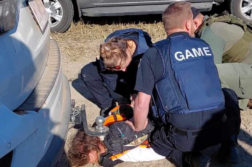The social, online and print media response to Adrian Bayley’s sentencing hearing could have helped make us safer.
Instead, space was devoted to stories about the kebabs he ate with his girlfriend the day after his crimes. A “secret fling” he may have had. Video clips of Bayley getting out of a police car. Photos of Jill Meagher’s distraught family. People commenting that they would “put a bullet through his head and invoice his family for the bullet”. Interactive maps of the crime scene.
That space and time and energy could have helped save future lives by asking what causes men like Bayley to become violent sexual offenders in the first place and how those causes can be redressed before they result in rape and murder.
Yes – Bayley needs to be incapacitated. Yes – in this instance, our parole system failed catastrophically. Yes – it requires improvement and may benefit from the review currently on foot. Yes – Bayley’s previous rape sentences are controversial and the reasons for them are worthy of scrutiny.
But the exclusive focus on these considerations makes two fundamental mistakes. First, it assumes that human error is representative of the daily workings of the entire criminal justice system. Second, it makes sentencing policy the panacea for public safety.
Even if human judgment were always perfect and we had endless money for prisons, sentencing cannot ameliorate pains already inflicted nor can it bring people back to life.
A point made at Bayley’s sentencing hearing has been glossed over in the media and its significance largely ignored.
Professor James Ogloff, Foundation Professor of Clinical Forensic Psychology at Monash University and Director of Psychological Services for the Victorian Institute of Forensic Mental Health, gave a professional opinion about Bayley that was used by the Crown as evidence about the high likelihood of his re-offending.
As Justice Nettle noted in his sentencing remarks, this opinion gave a “framework or context” for Bayley’s sustained and terrifying sexual violence which explained it without excusing it. Ogloff diagnosed Bayley as having traits consistent with Borderline Personality Disorder, impeding his ability to control emotions and behaviour.
Ogloff explained that although around 40 per cent of the disorder is genetic, its expression depends for the most part on environmental factors. We heard that its expression in Bayley was heightened by physical abuse by his father starting from when he was nine years old. There was also discussion of possible sexual abuse from an older female which began around the same time.
Whether or not we believe this in Bayley’s case, seeking an explanation for violent sexual offending is the difference between acting to prevent it in future or reacting to it after it occurs.
The media could have used its vast power, particularly at this time of heightened awareness, to seek such explanations.
It could have investigated the factors that coalesce to create sexually violent offenders like Bayley who derive sadistic pleasure from hurting women. It could have asked whether repeat offending of that nature is a matter of rational choice or pathology, and if the latter, whether it can be treated, whether its causes are inherent or environmental, and how they can be counteracted. It could have asked how our government is addressing the root causes of violence against women.
Journalists could have asked what lessons Bayley’s appalling criminal history — of rape starting from when he was 18 years old with a quarter of his life spent in gaol — teaches about the efficacy on relying largely on the blunt tools of policing and punishment after the fact. They could have asked why his previous sex offender program failed, whether that program represented best practice and was sufficiently funded. Whether other countries are doing this better.
They could have asked whether the money we are currently spending on building bigger prisons would be better spent on empirically-proven psychological early interventions and behaviour change programs for male offenders who have displayed these attitudes towards women. They could have asked where relying so heavily on criminal solutions to problems which are also matters of social and health policy has gotten us.
Journalists could have engaged with Professor Ogloff’s evidence about the links between childhood trauma and future emotional and behavioural functioning. They could have debated the merits of the empirical evidence about long-term impacts of witnessing, and being a victim of, domestic violence as a child.
Such discussion is vital one in Victoria, where family incident reports submitted by police rose from 40,839 in 2010/11 to 50,382 in 2011/12 and where children are routinely involved in family violence police call outs and cases flooding our specialist family violence courts. Many people overcome childhood trauma. There is not a rule that child victims go on to become adult offenders. But there are some who repeat cycles of violence.
All of which is to say, we could have had a public dialogue about public safety that involved cures and not band-aids.
Instead, most of the coverage was characterised by sensationalist details about Bayley’s crimes and demands for superficial, knee-jerk solutions which have already been demonstrated not to deter.
There were reported calls for mandatory sentencing — a sledge hammer to crack a walnut. Besides reacting only after crimes have been committed, mandatory sentencing uses a broad-brush approach which, when used elsewhere, has been shown to be ill-suited to selective incapacitation. It would waste correctional resources we do not have on people they weren’t intended for, with detrimental collateral consequences for families and crime rates. If this approach worked, the US would be one of the safest places on earth.
There were reports heralding a new criminal offence of breaching parole. This is a stop-gap at best, insufficient to “stop future Bayleys”.
There were reports of increased policing of parole violators and bail jumpers who “will continue to commit offences from shoplifting to murder”. The problem of targeting “shoplifters to murderers” is that it widens the policing net to the point where those who pose an actual risk of violent and sexual re-offending are lost in the sheer numbers. Reactions of this type are responsible for the issues Victoria currently faces with its voluminous sex offender registry: when we remove the discretion of judges to make meaningful distinctions in culpability, we overload our systems to the point where the real threats aren’t apparent and cannot be effectively monitored.
The arguments for indiscriminately harsh punishments, more offences, bigger prisons and wholesale restrictions to parole and bail which have been given so much room over the last week are symbolic but not effective. Instead of “getting tough on crime” they increase our vulnerability because they do not address the causes of offending and they come at a horrible cost. They are funded at the expense of — among other things — a proper commitment to early intervention programs and other social, health and education programs which are capable of breaking cycles of violence.
If we want safer streets, we need to do something useful with our anger and demand a rational, evidence-based approach to crime prevention. The approach that we are continually reading about now — relying on increasing levels of “law and order” after the damage has already been done – sells papers and gets votes but it doesn’t work. Pushing it harder also won’t work. We can do better.
Donate To New Matilda
New Matilda is a small, independent media outlet. We survive through reader contributions, and never losing a lawsuit. If you got something from this article, giving something back helps us to continue speaking truth to power. Every little bit counts.



